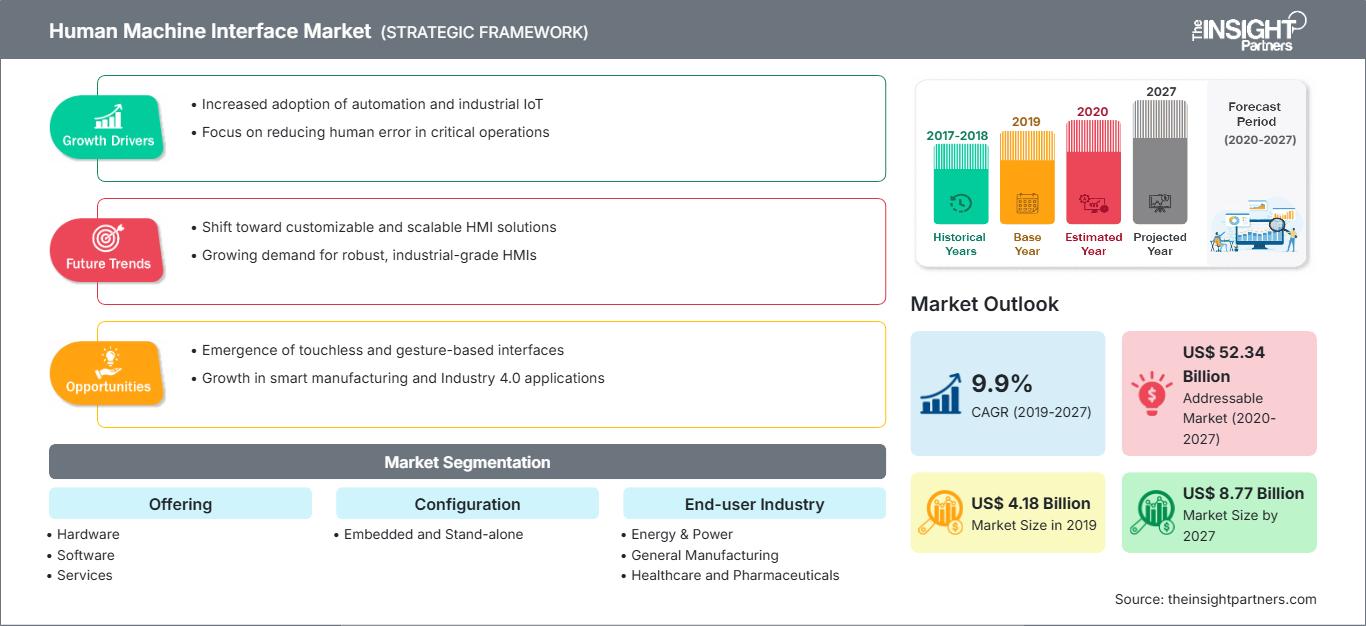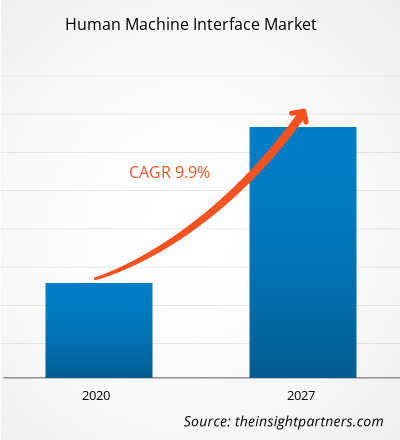2019 年人机界面市场规模为 41.8 亿美元,预计到 2027 年将达到 87.7 亿美元;预计 2020 年至 2027 年的复合年增长率为 9.9%。
人机界面市场大致分为五大区域——北美、欧洲、亚太地区、中东和非洲地区以及南美地区。欧洲占据全球最大市场份额,其次是亚太地区和北美。由于技术不断进步,随着物联网 (IoT) 和机器对机器 (M2M) 在该地区各行各业的应用不断加强,人机界面领域的研发活动也不断增加,美国和加拿大共同主导着北美人机界面市场。由于制造业的蓬勃发展以及先进工业运营监控技术的应用日益广泛,预计亚太地区市场复合年增长率将最高。
人机界面是一种图形化软件应用程序,它为操作员或用户提供有关操作流程的信息,实现人机交互,从而使机器能够接收指令并执行操作员指定的任务。换句话说,HMI 是一个中央控制系统,有助于传达操作员的输入,并实时接收来自各种 PLC 逻辑控制器的数据和反馈。它能够洞察控制系统内部的动态,追踪各种流程的宝贵输出信息,包括循环计数、时间和配方。HMI 可以提高用户绩效并确保数据安全。尽管部署这些产品初期的高昂成本对其生产构成了挑战,但 HMI 的应用并不仅限于制造企业。
自定义此报告以满足您的要求
您将免费获得任何报告的定制,包括本报告的部分内容,或国家级分析、Excel 数据包,以及为初创企业和大学提供超值优惠和折扣
人机界面市场: 战略洞察

-
获取本报告的主要市场趋势。这个免费样本将包括数据分析,从市场趋势到估计和预测。
自动化设备、机械、控制器和人机界面解决方案的采用迅速增加,已在不同行业垂直领域获得了显著的吸引力。因此,人们迅速采用了配备人机界面的产品、设备和系统,以促进工业机械与人之间的通信。人机界面的集成带来了改进的报警系统、卓越的工厂管理、故障排除、报告和分析以及资产管理等好处,这极大地促进了不同最终用户行业采用各种人机界面应用程序。此外,制造业、能源和电力、采矿业、石油和天然气行业中集成监控和数据采集 (SCADA) 系统的可用性天然气和其他重型机械行业也引发了全球发达国家和发展中国家 HMI 的部署。
新冠疫情对人机界面市场的影响
由于工业活动的停止,以及随之而来的集成服务和新型人机界面产品销售需求的下降,预计人机界面市场的销售额将大幅下降。此外,不同地区各类零部件制造商和设备供应商的运营受限,预计也会阻碍 HMI 面板和其他对界面至关重要的零部件的生产。因此,至少在未来几个月,疫情可能会抑制市场的增长。
基于产品的市场洞察
根据产品,人机界面市场细分为硬件、软件和服务。一些基于人机界面的产品提供触发器评估、板载逻辑、操作能力和事件管理器等功能。这些功能主要用于渲染更精细的显示,但也可以用作计算机逻辑的一部分。有大量的 I/O 选项可供选择,例如根据任务性质,提供多种数字或模拟输入或输出;通信协议也多种多样,从简单的 RS-232 链路到更高级的协议,例如 SERCOS、CANOpen 和基于以太网的通信。
基于配置的市场洞察
近年来,人机界面最令人振奋的进步之一在于其解决方案的远程访问功能。最先进的人机界面还配备了板载 Web 服务器,允许在任何可运行 Web 浏览器的外部设备(例如台式机、智能手机或平板电脑)上显示本地显示。嵌入式文件传输协议 (FTP) 服务器允许开发人员远程轻松地升级和备份 HMI 配置。一些人机界面可以发送电子邮件,提醒用户生产状态。此类远程访问功能可以以新的方式扩展设备的自动化功能,并且是选择 HMI 的重要因素。 2019 年,嵌入式 HMI 占据了全球人机界面市场的主导地位。
基于最终用户行业的洞察
由于工业最终用户和流程数量庞大,人机界面在不同行业中有着广泛的应用。例如,人机界面用于制造工厂、发电厂、石油和天然气行业、重型机械、电气和电子行业。因此,根据最终用户行业,全球人机界面市场大致细分为能源和电力、一般制造业、医疗保健和制药、汽车等。其他细分市场包括食品和饮料、航空航天和国防、采矿、电气和电子以及海洋工业。
全球人机界面市场参与者采用不同的策略,例如产品开发和扩展,以满足不断增长的需求,从而扩大其全球影响力。他们采用这一策略主要是为了在北美和欧洲发展业务。这些参与者采用扩张和投资战略来扩大全球客户群,这也使他们能够在全球范围内维护自己的品牌。以下列出了一些最近的发展:2020 年:罗克韦尔自动化公司在美国签署协议,公布了收购俄亥俄州 Kaly 公司的计划。Kalypso 是一家软件交付和咨询公司,专注于工业领域公司的数字化转型,提供全套咨询、企业技术、数字创新和业务流程管理服务。因此,此次收购将有助于罗克韦尔自动化加强其企业软件咨询和信息架构的产品和服务组合。2020 年:罗克韦尔自动化公司签署协议收购 ASEM, SpA。ASEM 总部位于意大利,提供全系列工业 PC、HMI 硬件和软件、安全的工业物联网 (IIoT) 网关解决方案以及远程访问功能。2018 年:罗克韦尔自动化更新了其 FactoryTalk View HMI 软件。该软件版本 10.0 的新功能包括更强大的信息访问、新的移动设备支持以及更好的跨软件集成,从而提高生产力。
人机界面市场区域洞察
The Insight Partners 的分析师已详尽阐述了预测期内影响人机界面市场的区域趋势和因素。本节还讨论了北美、欧洲、亚太地区、中东和非洲以及南美和中美洲的人机界面市场细分和地域分布。
人机界面市场报告范围
| 报告属性 | 细节 |
|---|---|
| 市场规模 2019 | US$ 4.18 Billion |
| 市场规模 2027 | US$ 8.77 Billion |
| 全球复合年增长率 (2019 - 2027) | 9.9% |
| 历史数据 | 2017-2018 |
| 预测期 | 2020-2027 |
| 涵盖的领域 |
By 产品
|
| 覆盖地区和国家 |
北美
|
| 市场领导者和主要公司简介 |
|
人机界面市场参与者密度:了解其对业务动态的影响
人机界面市场正在快速增长,这得益于终端用户需求的不断增长,而这些需求的驱动因素包括消费者偏好的演变、技术进步以及对产品优势的认知度的提升。随着需求的增长,企业正在扩展其产品线,不断创新以满足消费者需求,并抓住新兴趋势,从而进一步推动市场增长。

- 获取 人机界面市场 主要参与者概述
- 硬件
- 基于 PC
- 基于面板
- 其他
- 软件
- 本地
- 云
- 服务
人机界面市场 — 按配置
- 嵌入式
- 独立式
人机界面市场 — 按最终用户行业
- 能源与电力
- 通用制造业
- 医疗保健和制药
- 汽车
- 其他
人机界面市场 - 按地域
- 北美
- 美国
- 加拿大
- 墨西哥
- 欧洲
- 法国
- 德国
- 意大利
- 英国
- 俄罗斯
- 欧洲其他地区
- 亚太地区
- 中国
- 印度
- 韩国
- 日本
- 澳大利亚
- 亚太其他地区
- 中东和非洲
- 南非
- 沙特阿拉伯
- 阿联酋
- 中东和非洲
- 南美洲
- 巴西
- 阿根廷
- 南美洲其他地区
人机界面市场 - 公司简介
- ABB 有限公司
- 研华有限公司
- 通用电气公司
- 霍尼韦尔国际公司
- 控创科技股份公司
- 三菱电机株式会社
- 罗克韦尔自动化公司
- 施耐德电气
- 西门子股份公司
- 横河电机株式会社
- 历史分析(2 年)、基准年、预测(7 年)及复合年增长率
- PEST和SWOT分析
- 市场规模、价值/数量 - 全球、区域、国家
- 行业和竞争格局
- Excel 数据集
近期报告
相关报告
客户评价
购买理由
- 明智的决策
- 了解市场动态
- 竞争分析
- 客户洞察
- 市场预测
- 风险规避
- 战略规划
- 投资论证
- 识别新兴市场
- 优化营销策略
- 提升运营效率
- 顺应监管趋势






















 获取免费样品 - 人机界面市场
获取免费样品 - 人机界面市场